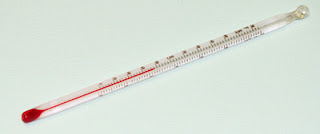- Pinwheel Calculator
- "The operation of machines of this type was accomplished by means of pulling levers or knobs to set up the desired number. Addition, subtraction, multiplication, and division were accomplished by means of revolving drums.
Fahrenheit Scale:
- The temperature scale proposed in 1724 by, and named after, the German physicist Daniel Gabriel Fahrenheit (1686-1736)
- It was replaced by the Celsius scale in most countries during the mid to late 20th century, but it is still the official scale for the United States, Cayman Islands, and Belize.
- standard for climatic, industrial and medical purposes in English-speaking countries until the 1960's.
- Alcohol Thermometer
- The alcohol thermometer was the earliest, efficient, modern style instrument of temperature measurement.
- unlike mercury-in-glass thermometer, the contents of an alcohol thermometer are less toxic and will evaporate away fairly quickly
- Credited to Daniel Gabriel Fahrenheit in 1709
- Mercury Thermometer
- The mercury thermometer was invented in 1724
- Consists of mercury in a glass tube
- Calibrated marks on the tube allow the temperature to be read by the length of the mercury within the tube, which varies (nearly linearly) according to the temperature of the mercury.
- To increase the sensitivity, there is usually a bulb of mercury at the end of the thermometer which contains most of the mercury; expansion and contraction of this volume of mercury is then amplified in the much narrower bore of the tube.
- The space above the mercury may be filled with nitrogen or it may be less than atmospheric pressure, also known as a vacuum.
- The Industrial Revolution was a period from the 18th to the 19th century where major changes in agriculture, manufacturing, mining, transportation, and technology had a profound effect on the social. economic and cultural conditions of the times.
- Starting in the later part of the 18th century,there began a transition in manual labor economy towards a machine-based manufacturing economy.
- Between 1750 and 1815, only 7% of the German population live in cities. Life in the villages changed, however. Agriculture production became more intensive and large scale (to produce raw materials for the rural industry) and as a result, the number of farmers without land grew. Towns with rural industry grew and provided much work. World trade and politics became more influential in the every-day life of the villagers.
- The first Industrial Revolution, which began in the 18th century, merged into the Second Industrial Revolution by 1850, when technological and economic progress gained momentum.
- Textile Industry
- At this time, Germany's main industry was primarily concerned with the production of yarn and cloth.
- During the 18th Century, the textile industry grew to an industry of mass production.
- In the early 18th century, artisans were inventing ways to become more productive. SIlk, wool, fustian (cotton and low-quality wool mixed together,) and linen were being overshadowed by cotton, which was becoming the most important textile. This set the foundations for the changes.
- FACT: The United States would actually raise the cotton and export it out to European countries and cloth would be produced from this cotton.
- Negative Effects
- Along with advances in technology, there was an overall downfall in the economic and cultural situation of the people. Growth of cities were one of the major consequences of the Industrial Revolution. Many people were driven to the cities to look for work.
- With the new industrial age, the new quantitative and materialistic view of the world took place. This caused the need for people to consume as much as they could without having the means to support their new habits. People were living on small wages that required small children to work in factories for long days in order to keep up with their new lifestyle.
Source #1 November 7, 2011
Source #2 November 7, 2011
Source #3 November 7, 2011
Source #4 November 7, 2011




